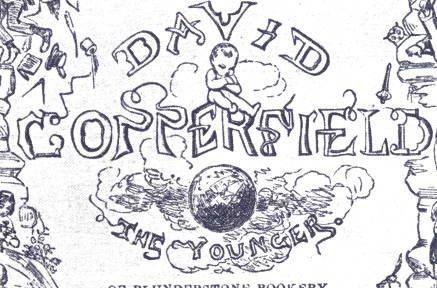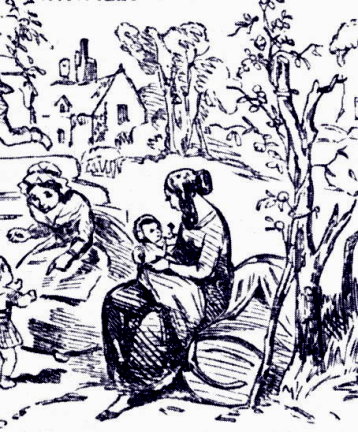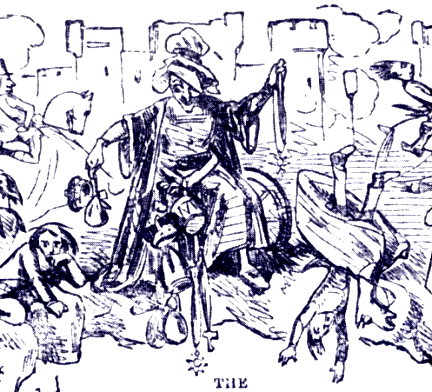[Click on thumbnail for larger image]
The green monthly wrapper of a new Dickens novel, which remained unchanged except for date and part number during its nineteen-month serial run, gave readers their first the indication of the novel's issues, situations, characters, setting, and themes. And these wood-engraved wrappers were especially important to readers of the first issue. In the case of The Personal History, Adventures, Experience, & Observation of David Copperfield The Younger of Blunderstone Rookery (Which He never meant to be Published on any Account), however, the illustrator, Hablot K. Browne had rather less on which to base his design of the wrapper than had been the case with Dombey and Son (1846-48) or would be the case with A Tale of Two Cities (1859). In this respect, the design's focus on a theme (in this case, the life of a bourgeois) has much in common with that for Martin Chuzzlewit (1842-43), which focuses on the morally corrosive effects of egotism without providing instances of characters and situations that will appear in the novel. In the case of the wrapper for Dombey and Son, Dickens was concerned that, in furnishing the likenesses of the cast of characters to exemplify the theme of "Pride Goeth before a Fall," Phiz had telegraphed too much in advance to the reader. The wrapper for David Copperfield certainly presents no such difficulty since it appears that at the stage when Charles Dickens recruited him for the Bradbury and Evans project he had revealed nothing to his illustrator but the governing conception of the new story as a male bildungsroman, or novel of development.
By the time in early 1849 that Dickens, who had already composed his famous autobiographical fragment, began to create a pattern of plot and characters into which he could integrate the story of his own troubled youth in David Copperfield, he had worked with a number of illustrators, most notably Hablot Knight Browne or Phiz. They had already collaborated exclusively on The Pickwick Papers (1836), Nicholas Nickleby (1838-9), Martin Chuzzlewit, and Dombey and Son, and partially on The Old Curiosity Shop (1840-41) and Barnaby Rudge (1841). Apart from Phiz, Dickens had worked with George Cruikshank, George Cattermole, Robert Seymour and John Buss, as well as more recently with teams of illustrators to produce the Christmas Books (1843-48). Whatever the talents of Daniel Maclise, Frank Stone, John Tenniel, Clarkson Stanfield, and the leading Christmas Book illustrator, the caricaturist and Punch humourist John Leech, Dickens realized that an extended work such as Copperfield required a unity of vision and imagination that no team could deliver. For over a dozen years Phiz had reliably and often brilliantly realized his characters, visualized his humour, and conveyed his social realism, so Dickens saw need to change illustrators for what would prove at a personal level the most important novel of his life — whether for grotesques, settings, or fancies, Phiz was best suited artistically and temperamentally to the range of Boz. Thus, Dickens commissioned him to collaborate on his fifteenth major work and seventh full-length novel. Nonetheless, although Dickens's confidant and legal advisor, John Forster, from the first knew of the autobiographical fragment and its relationship to the early stages of Copperfield, Dickens appears to have kept Phiz in the dark for all nineteen monthly parts. Moreover, on the wrapper Phiz
could not portray the Murdstones, Micawbers, Wickfields, Spenlows, and Heeps, who stimulate David's inner growth, because Dickens had not yet committed them to paper, but such a generalized cover was not likely to contradict Dickens's narrative in any important way. [Cohen 100]
Given the episodic structure of the bildungsroman and Dickens's unprecedented use of the first-person narrator in a work of volume length, Phiz faced unusual challenges. First, while maintaining visual continuity between the wrapper design and the forty full-page illustrations to follow, Phiz would not be able to provide images of any characters other than David himself until he encountered them instalment by instalment. Secondly, especially in the monthly plates, Phiz would have to translate the memories of the protagonist-narrator into a third person objective or dramatic point of view. Moreover, as Cohen notes above, since the novelist had not communicated the trajectory of the plot and the particulars of setting and character, the illustrator would have to use an organizing principle in the wrapper that would be universally applicable to middle-class existence. Thus, Phiz utilizes the common Renaissance "Stairway of Life" motif with a sequence of growing-up scenes from the bottom and up the left-hand margin:
Like its immediate predecessor [the Dombey and Son wrapper], the design is organized in terms of a series of figures ascending on the left and descending on the right, to and from a single figure at the apex. But here the stream of figures is continuous, from birth at lower left to death at lower right, with the cycle beginning over again in the child playing horsey with the tombstone (a scene which Browne had etched six years earlier in the frontispiece to Thomas Miller's Godfrey Malvern, where it derives from the text). The total sequence recalls the Seven Ages of Man, with a mocking Fortuna at the top, as well as modern fools with hobbyhorses, and castles in the air. . . . The single detail which appears to bear specifically on events in David Copperfield is the child playing with the gravestone, which foreshadows both Clara's death and David's shock at discovering that life goes on. But this allusion may be no more than coincidental. (The inclusion of a mother, child, and nurse in the plate is not necessarily a specific reference to David, his mother, and Peggotty.) [Steig 114]
The central globe is an interesting feature that perhaps alludes to Dickens's original working title for the novel, The Copperfield Survey of the World as it Rolled (see Letters, V, 502: "To John Forster," 26 February 1849), although some early manuscript pages in the Victoria and Albert Museum use the draft title "Mag's Diversions."

The Pilgrim editors note "an undated handbill printed by Bradbury & Evans" (503) as suggestive of this being the working title until close to the date of the publication of the initial instalment; in writing to Forster again on 28 February 1849, Dickens referred to it among the list of six possible titles for the novel as "my favourite from the first" (503), and mentioned that it had received the endorsements of both his wife, Catherine, and sister-in-law, Georgina Hogarth, as well as of Forster himself. Sadly, the surviving correspondence does not mention Phiz's involvement in the project until after it was launched at the beginning of May.
The clockwise sequence begins at the very bottom of the wrapper with the young mother and infant (who might, as Steig suggests, be any mother and child rather than specifically Clara and the infant David) in front of a cottage and trees, the leaves of the tree behind them implying spring and the first stage of life.

The other side of the tree, damaged and leafless, ends the narrative-pictorial sequence with the next child playing horsey between the tombstones and in company with a sexton, shovel in hand, implying both the end of life and of the story. Aside from the mother and child figures at the bottom, none seems directly related to the novel's cast of characters. As opposed to individualised figures in a premonitory visualisation of the narrative, Phiz has utilized Jacques's speech "Seven Ages of Man" from in II, vii, 139-166 of Shakespeare's As You Like It. The gravedigger, then, may conceivably be a second Shakespearean allusion (to the rascal word-monger of Hamlet). The imaginary castle could as easily be that of the villain in "Jack the Giant-Killer" as Elsinore in Dickens's favourite Shakespeare tragedy, suggesting two of the novelist's favourite sources of inspiration, Literary classics and traditional fairy tales. The fools and their hobbyhorses Phiz has borrowed from Quarles's Emblemes, an 18th c. source book of imagery which he had already utilized for the angels in boats on the Dombey wrapper. Although at the start Dickens conveyed little to Browne about the characters who would appear in the growing-up story, Browne correctly surmised that the male protagonist would of necessity have childhood friends and in later youth companions of his own age, so that the careful viewer notes pairs of boys such as (perhaps) David and Tommy Traddles beside the cottage, and again tentatively David and Steerforth immediately above the previous pair.
The undefined hero is portrayed as an infant in his mother's lap, a child toddling between his mother and his nurse, a schoolboy, a suitor, a parent, a prosperous gentleman, and . . . an old man beckoned to his grave. (Cohen 100)
The number and type of figures in the wrapper are as telling as their upward/downward disposition: as opposed to forty-one males (many of them iterations of the central character from birth to maturity and old age), there are just eleven females. Moreover, compared to the less populated wrappers of earlier novels, that for Copperfield seems crowded with paired figures, the only obvious figure being the androgynous Dame Fortuna presiding at the apex, her features partly obscured by her large hat.

Her wheel behind her, she stands directly below the entrance of the Castle of Life and the designated month, holding purses and medals on ribbons, her right arm weighed down, but her left hand raised. In terms of print, as the controller of the characters' destinies, the author has his name prominently displayed as the largest line, discounting the stylized "David Copperfield." "With illustrations by H. K. Browne," on the other hand, appears in much finer print and immediately under the author's name, as if the page layout is proclaiming the relative importance of each collaborator.
References
Cohen, Jane R. "Dickens and His Principal Illustrator, Hablot K. Browne." "Hablot Knight Browne ("Phiz")." Charles Dickens and His Original Illustrators. Columbus, Ohio: Ohio U. P., 1980. Pp. 60-122.
Dickens, Charles. David Copperfield. Il. Hablot Knight Browne. Bloomsbury: The Nonesuch Press, 1937; rpt., London: The Overlook and Worth Press, 2005.
_____. The Letters of Charles Dickens. Volume 5: 1847-1849. Ed. Graham Storey and K. J. Fielding. The Pilgrim Edition. Oxford: Clarendon, 1981.
Steig, Michael. "David Copperfield: Progress of a Confused Soul." Dickens and Phiz. Bloomington: Indiana U. P., 1978. Pp. 113-130.
Stone, Harry. "David Copperfield." Dickens' Working Notes for His Novels. Chicago: U. Chicago Press, 1987. Pp. 102-179.
Last modified 19 January 2009
